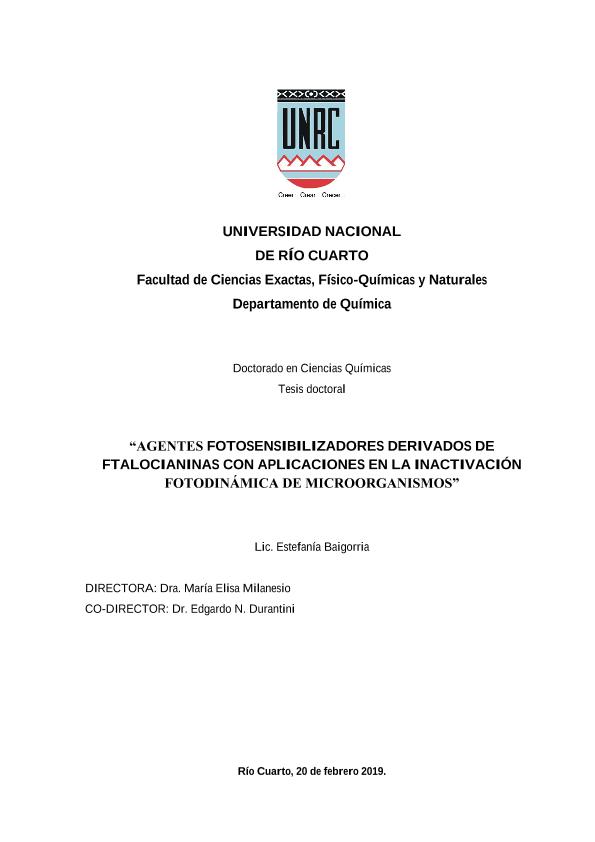Tesis doctoral
El uso indiscriminado de fármacos frente a infecciones microbianas ha generado el advenimiento de la resistencia a múltiples medicamentos en los microorganismos. La inactivación fotodinámica (PDI) ha sido propuesta como una terapia alternativa para la erradicación de microbios. En este sentido, diferentes estudios han mostrado que derivados de ftalocianinas presentan utilización potencial como agentes fototerapéuticos. Así, en este trabajo de tesis, se sintetizaron diferentes derivados de ftalocianinas con el fin de utilizarlos en tratamientos de PDI. Inicialmente, se obtuvieron tres ftalocianinas catiónicas (CF3(NM3)3-ZnPc3+, A(NM3)3-ZnPc3+ y (NM3)4-ZnPc4+) con el objetivo de utilizarlas como fotosensibilizadores. Los estudios espectroscópicos mostraron las bandas de absorción y emisión de fluorescencia características de esta familia de compuestos. La molécula A(NM3)3-ZnPc3+ generó especies reactivas de oxígeno (ROS) con alta eficiencia. Los experimentos de PDI se realizaron en Candida albicans, Staphylococcus aureus y Escherichia coli. Los resultaron indicaron que A(NM3)3-ZnPc3+ fue muy efectiva para la erradicación de microorganismos. Por otra parte, se sintetizaron conjugados de ftalocianinas con polímeros precursores catiónicos, tales como quitosano (Q-ZnPc) y polietilenimina (PA-ZnPc). Estos polímeros pueden adquirir cargas positivas en el medio biológico debido a la disponibilidad de grupos amino libres que presentan. Las características espectroscópicas de absorción, fluorescencia e IR indicaron la funcionalización de los conjugados ftalocianinas-polímeros. Además, presentaron considerables rendimientos cuánticos de generación de oxígeno singlete () tanto en DMF como en medio acuoso. Los estudios de PDI indicaron que PA-ZnPc presentó una mayor eficiencia en la erradicación de C. albicans y S. aureus, comparado con Q-ZnPc. Debido a la baja inactivación de E. coli por parte de estos conjugados, la PDI se potenció con el agregado de quitosano. Por último, se llevó a cabo la síntesis de ftalocianinas con el objetivo de formar películas poliméricas con aplicación en PDI (EDOT-ZnPc y EDOT-CuPc). Mediante la voltametría cíclica de EDOT-Pcs se formaron electropolímeros con características espectroscópicas y fotoquímicas interesantes para su aplicación en PDI. EDOT-ZnPc/película presentó un mayor efecto en la erradicación de S. aureus en suspensiones celulares planctónicas y en biopelículas con el agregado de KI al medio. Estas películas fotoactivas pueden ser aplicadas en la inactivación de microorganismos evitando la acumulación del PS en el medio y permitiendo su reutilización en tratamientos posteriores. The inappropriate use of the drugs against microbial infections has generated the advent of multidrug resistance in microorganisms. The photodynamic inactivation (PDI) has been proposed as alternative therapy to eradicate microbial cells. Different studies have shown that phthalocyanine derivatives have the potential use as phototherapeutic agents. Thus, in this thesis work, different phthalocyanine derivatives were synthetized with the aim of using in PDI treatment. First, three cationic phthalocyanines (CF3(NM3)3-ZnPc3+, A(NM3)3-ZnPc3+ y (NM3)4-ZnPc4+) were obtained with the objective of being used as photosensitizers. The spectroscopic studies showed the absorptions bands and emission of the fluorescence bands characteristics of these compounds. The A(NM3)3-ZnPc3+ molecule generated reactive oxygen species (ROS) with high efficiency. The PDI experiments were accomplished in Candida albicans, Staphylococcus aureus and Escherichia coli. The results indicated that A(NM3)3-ZnPc3+ was more effective for the microbial eradications. Moreover, phthalocyanines conjugated with cationic precursors polymers were synthetized, such as chitosan (Q-ZnPc) and polyethylenimine (PA-ZnPc). These polymers can take positive charges in biological medium due to the availability of the free amine groups. The absorptions, fluorescence and IR spectroscopic bands are characteristic of these compounds indicated to the functionalization of the phthalocyanine-polymer conjugates. In addition, they presented considerable quantum yields of the oxygen singlet generation () in both DMF and aqueous medium. The PDI studies indicated that PA-ZnPc presented a high efficiency in the C. albicans and S. aureus eradication, compared to Q-ZnPc. Due to the low inactivation of the E. coli by the conjugates, the PDI was potentiated with the addition of chitosan. Finally, was carried out the synthesis of the phthalocyanines with the objective of form polymeric films with the PDI applications (EDOT-ZnPc y EDOT-CuPc). By cyclic voltammetries of the EDOT-Pcs were formed electropolymers with spectroscopies and photochemistry characteristics interesting for the PDI applications. EDOT-ZnPc/film presented a high effect in the S. aureus eradication in planktonic cellular suspensions and in biofilms with the KI added to the medium. These photoactive films can be applied in PDI avoiding the accumulation of photosensitizers in the medium and allowing reusing the films in later treatments.
Agentes fotosensibilizadores derivados de Ftalocianinas con aplicaciones en la inactivación fotodinámica de microorganismos
Baigorria, Estefanía

Director:
Milanesio, María Elisa

Codirector:
Durantini, Edgardo Néstor

Fecha de publicación:
20/02/2019
Idioma:
Español
Clasificación temática:
Resumen
Palabras clave:
Ftalocianinas
,
Actividad Fotodinamica
,
Sintesis
,
Fotosensibilizadores
Archivos asociados
Licencia
Identificadores
Colecciones
Tesis(CCT - CORDOBA)
Tesis de CTRO.CIENTIFICO TECNOL.CONICET - CORDOBA
Tesis de CTRO.CIENTIFICO TECNOL.CONICET - CORDOBA
Citación
Baigorria, Estefanía; Milanesio, María Elisa; Durantini, Edgardo Néstor; Agentes fotosensibilizadores derivados de Ftalocianinas con aplicaciones en la inactivación fotodinámica de microorganismos; 20-2-2019
Compartir



